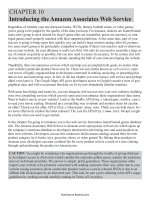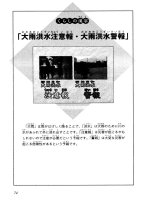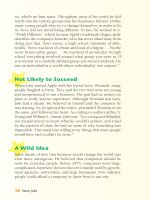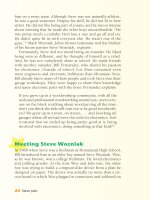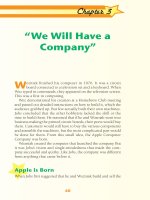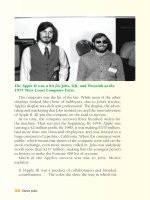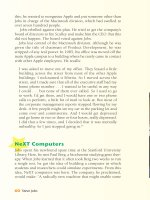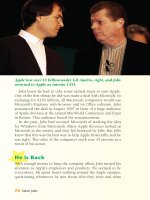Steve Jobs.Other books in the People in the News series phần 6 ppsx
Bạn đang xem bản rút gọn của tài liệu. Xem và tải ngay bản đầy đủ của tài liệu tại đây (1.23 MB, 10 trang )
50
Steve Jobs
The computer was the hit of the fair. While most of the other
displays looked like those of hobbyists, due to Jobs’s resolve,
Apple’s display was slick and professional. The display, the adver-
tising and marketing that Jobs insisted on, and the innovativeness
of Apple II, all put the company on the road to success.
In no time, the company received three hundred orders for
the machine. That was just the beginning. By 1978, Apple was
turning a $2 million profit. By 1980, it was making $335 million,
had more than one thousand employees, and was housed in a
huge campus in Cupertino, California. When the company went
public, which means that shares of the company were sold on the
stock exchange, even more money rolled in. Jobs was suddenly
worth more than $217 million, making him the youngest person
in history to make the Fortune 400 list of tycoons.
Much of the Apple’s success was due to Jobs. Moritz
explains:
It [Apple II] was a product of collaboration and blended
contributions . . . The color, the slots, the way in which the
The Apple II was a hit for Jobs, left, and Wozniak at the
1977 West Coast Computer Faire.
“We Will Have a Company”
51
memory could be expanded . . . the control of the keyboard
. . . was Wozniak’s contribution. Holt [an Apple employee]
had contributed the extremely significant power supply and
Jerry Manock the case . . . But behind them all Jobs was
poking, prodding, and pushing and it was he, with his seem-
ingly inexhaustible supply of energy, who became the chief
arbitrator and rejector.
39
Attention to Detail
One reason for Apple II’s success was that Jobs was as con-
cerned about the machine’s construction as its appearance. For
instance, he insisted that the wires connecting the computer chips
on the computer’s internal circuit board be perfectly straight,
even though nobody saw them. Attention to detail, he believed,
showed consumers the company cared, creating a loyal customer
base. Throughout his career, Jobs demanded this same attention
to detail in all the company’s products. Once again, Jobs was
right. Apple’s customers are extremely loyal.
To make the outstanding products, Jobs hired the most tal-
ented people he could find. He treated them more like artists
than scientists, trying to inspire them to do their finest work.
But he was brash and outspoken and was not considerate of their
feelings. Although he made a point of publicly praising Apple
employees and rewarding them lavishly with things like cash and
stock options, all expense paid vacations, bonuses, and individual
research budgets, he also openly criticized and humiliated them if
they did careless work. Some found him impossible to work with,
while others adored him. “My job is not to be easy on people,”
he explained. “My job is to make them better.”
40
A Different Company
Jobs also tried to make the company completely different from
other workplaces. He did whatever it took to foster creativity. Each
building had its own theme and name chosen by the employees.
52
Steve Jobs
For instance one building was named the Land of Oz; it housed
the Dorothy and Toto conference rooms. And, each floor had a
lounge area equipped with red-topped popcorn stands where
employees could visit and share ideas.
In addition, there were no set work hours. Employees came
and went at will. When they were involved with a project, many,
including Jobs, worked day and night. Nor was there a dress
code. Jeans and tee shirts were the norm. Jobs wore a black turtle-
neck and jeans almost everyday, an outfit he made famous.
A Confusing Personal Life
Those early days at Apple were some of the happiest in Jobs’s
career. But things were not going as well in his personal life. Jobs
was sharing a house with Chris-Ann Brennan, but he was more
interested in Apple than in their relationship. On May 17, 1978,
Brennan gave birth to a baby girl, whom she named Lisa. Brennan
Apple has different workspaces than most companies to
help foster creativity.
“We Will Have a Company”
53
said Jobs was the father. For the next two years, he denied the
baby was his and refused to pay child support.
In 1980, Brennan took Jobs to court. He was forced to pay
child support, but he still refused to see his daughter. No one
knows why Jobs acted this way. Eventually, he came to acknowl-
edge and love Lisa, but it took time. In the interim he continued
focusing all his attention on his other baby, Apple.
Kids Can’t Wait
I
n 1979, few schools had computers. Jobs strongly believed
that if every school had at least one computer, it would
change students’ lives. He proposed that Apple donate a com-
puter to every school in the United States. This would have
cost Apple 100 million dollars, which the company could not
afford. But, if Apple could donate the computers and take a
tax deduction, as was allowed for donations to universities, the
cost would be 10 million dollars, which Apple could afford.
Jobs enlisted the aid of California congressman Pete Stark.
He and Jobs drafted the “Kids Can’t Wait Bill,” which made
donations of equipment to K-12 schools tax deductible. Jobs
spent two weeks in Washington lobbying for the bill.
Unfortunately, the bill never reached the Senate floor.
However, the state of California thought the bill was a good
idea and passed a similar bill that covered the state. As a result,
Apple donated one computer to every school in California. It
donated software and provided free training for teachers. Jobs
says that getting computers into the hands of children in this
way is one of his greatest accomplishments.
54
Chapter 4
Down but Not Out
J
obs continued to take Apple to new heights. But in 1985 a
power struggle within the company caused Steve to lose his
job. He took on new projects, spending almost all his money try-
ing to make them successful. When it looked like he was about
to lose everything, he managed to turn things around. Not only
did his new projects turn out to be extremely successful, Apple
asked him to come back. The company was lost without him.
Steve Jobs was Apple.
A New Idea
With his private life in turmoil, Jobs moved out of the house he
shared with Chris-Ann Brennan and bought an old mansion in
Los Gatos, California. Except for a few cushions and a mattress on
the floor of his bedroom, he never furnished it. Nor, did he spend
much time in the house. His real home was Apple, where his lat-
est goal was to create a new computer. To help with financing,
he got the office machine company Xerox to invest one million
dollars in Apple.
A visit to Xerox PARC, the company’s research center, provided
Jobs with inspiration. He saw a demonstration of a revolutionary
computer named Alto that Xerox was working on. It had a point
and click graphic user interface.
Down but Not Out
55
Until then, it was necessary to type in complicated commands
to direct the computer. The point and click graphic user interface
allowed users to make selections by moving a pointer to onscreen
items, which would open individual windows for different docu-
ments and cause onscreen menus to pop up. Although this is
standard operating procedure today, back then it was revolution-
ary. Xerox, however, did not recognize the computer’s potential
and did not intend to market it. Jobs, on the other hand, immedi-
ately grasped the importance of the technology. He recalls, “When
I went to XEROX PARC in 1979, I saw a rudimentary graphical
user interface. It wasn’t complete. It wasn’t quite right. But within
10 minutes, it was obvious that every computer in the world
would work this way someday.”
41
Macintosh: Revolution in a Box
Jobs went back to Apple obsessed with creating a computer based
on the technology he had seen at Xerox. His first try was a com-
puter called Lisa, which was the first computer he worked on
without Wozniak’s help. He was not happy with the team work-
ing on Lisa, or with the computer, which was large and expensive.
After visiting Xerox PARC, Jobs saw that a point and click
graphic user interface could revolutionize computers.
56
Steve Jobs
It was not the type of computer that the average person would
buy. So, in 1981, even before Lisa hit the market, Jobs turned his
attention to another new computer, the Macintosh (Mac), a low-
priced, user-friendly machine, conceived of by Apple engineer Jef
Raskin. It meshed perfectly with Jobs’s vision of the future. The
Macintosh was a computer for the average person. It would, Jobs
insisted, change the world.
Although Raskin came up with the original idea for the
Macintosh, it was Jobs who brought the machine into existence.
He handpicked an extremely talented team of about forty scien-
tists to build it, housed them in a separate building that flew a
pirate flag, and told them that it was better to be a pirate than to
join the navy. By this, he implied that it was okay to break the
rules.
A Private Individual
A
lthough Steve Jobs loves talking about his various busi-
nesses, he is less forthcoming about his personal life.
Little is known about how Jobs spends his wealth. He is not
very materialistic. He dresses in jeans, tennis shoes, and black
turtleneck shirts. He lives with his family in an average size
ranch-style home in a middle-class neighborhood in Palo Alto,
California, near Stanford University.
Although he is involved in charitable pursuits, he rarely
speaks of them. It is known that he set up charities in India
that help poor blind people.
Otherwise, he admits to being happily married, a Zen
Buddhist, and a vegetarian. In fact, he bought a vacant house
next door to his own house and tore it down in order to turn
the lot into a large organic garden. Here, he grows many of
the foods his vegetarian family consumes. He is so enthusiastic
about vegetarianism and eating healthy that he insisted the
vending machines at Apple and NeXT offered healthy snacks.
On Halloween, he hands out little bottles of carrot juice to
trick or treaters.
Down but Not Out
57
Pushing the Mac Team
The Mac team was Apple’s elite and Jobs let everyone in the
company know it. He gave team members medals, took them
to restaurants, served them freshly squeezed orange juice each
morning, surprised them with cash bonuses, and provided them
with first-class plane tickets. He even put a video arcade and a
piano in the lobby, so they would feel at home.
At the same time, Jobs was a strict taskmaster. He routinely
stood over team members’ shoulders, asking questions and fid-
dling with their work. When he did not like what he saw, he
yelled and criticized until changes were made. He fired team
members whose work did not live up to his standards. If he was
harsh, it was because he believed that the Macintosh was going
to change computing. He envisioned it as a revolution in a box.
Jobs insisted that the Mac be the most technologically advanced
computer of its time.
He was adamant that
it be half the size of
other computers and
extremely easy to
operate. It also had
to have a graphic
user interface, mul-
tiple fonts, support
sound, drawing, and
painting, and a have
a mouse, which was
a brand-new inven-
tion that he had
heard about. Such a
machine had never
been built before.
Jobs rewarded the
Mac team but also
strictly scrutinized
every step of their
work.
58
Steve Jobs
But Jobs’s team was the best around and he expected the
impossible from them. And, he convinced his team that they
were capable of building it. More than that he made them believe
that they were about to change the world. According to Mac team
member Trip Hawkins,
Steve has a power of vision that is almost frightening. When
he believes in something, the power of that vision can liter-
ally sweep aside any objections, problems, whatever. They
just cease to exist. The reason that Apple succeeded is that
we really believed in what we are doing. The key thing was
that we weren’t in it for the money. We were out to change
the world.
42
The Macintosh was a revolutionary machine. It was, according
to technology writer Leander Kahney,
Designed for ordinary people, not programmers, it dis-
pensed with blinking cursors and inscrutable instructions
for a child-friendly interface navigated by a simple . . . point-
ing system, the mouse . . . It played music, drew pictures,
and could speak for itself in a synthesized voice. As it booted
up, a friendly, smiley face shone from the screen. . . . The
technology was a good 10 years before its time.
43
And, just as Jobs envisioned, it brought ordinary people to
computing.
Jobs is Out
The Macintosh entered the market in 1984. Jobs spent over $1
million dollars advertising it, including a Superbowl XVIII com-
mercial. At first, sales were remarkable, but then they slowed.
Jobs predicted Apple would sell two million machines in the first
two years, but he was overly optimistic.
Industry wide, computer sales were poor and Apple was feel-
ing the slump.
The company was now a huge $2 billion corporation with
Down but Not Out
59
over seven thousand employees. Markkula and Wozniak were
gone. A year earlier, Jobs hired John Sculley, the former CEO of
Pepsi, to preside over Apple. At first the two men got along well,
with Sculley accepting Jobs’s vision of computers as household
appliances. But when Macintosh sales dipped, Sculley lost faith
in Jobs’s vision. “Apple was supposed to become a wonderful
consumer products company,” Sculley said. “This was a lunatic
plan. High tech could not be designed and sold as a consumer
product.”
44
Sculley was wrong, but nobody knew it at the time. He felt
the only way to boost Macintosh’s sales was to make the machine
more like a computer designed for business use. In order to do
When Apple sales slumped, John Sculley, center, lost faith
in Jobs’s vision.
